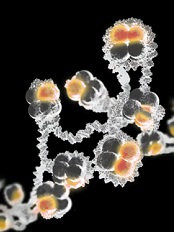
Credit: Eric Smith
Researchers have presented evidence to support the use of a BET protein antagonist in FLT3-ITD-mutated acute myeloid leukemia (AML).
The group’s experiments showed the antagonist, JQ1, was active against FLT3-ITD-expressing AML cells in vitro and in vivo.
The agent also demonstrated synergy with the tyrosine kinase inhibitor (TKI) AC220 and the histone deacetylase (HDAC) inhibitor panobinostat.
In fact, JQ1 and panobinostat in combination induced apoptosis in a TKI-resistant cell line.
Melissa Rodriguez, MD, PhD, of the Houston Methodist Research Institute in Texas, and her colleagues presented these findings at the AACR Annual Meeting 2014 as abstract 1721.
The BET protein family members, including BRD4, bind to acetylated lysines on histone proteins, help assemble transcriptional regulators at the target gene promoters and enhancers, and regulate the expression of oncogenes such as MYC and BCL-2.
JQ1 interferes with BRD4 binding to acetylated lysines on histone proteins, resulting in the displacement of the BET proteins. This, in turn, disrupts transcription initiation and elongation factors situated on the chromatin, thereby inhibiting expressions of c-MYC and BCL-2 and their target genes. And this leads to growth arrest and the induction of apoptosis in AML cells.
Dr Rodriguez and her colleagues found that JQ1 alone induced apoptosis in cultured mouse lymphoid cells such as Ba/F3/FLT3-ITD but also Ba/F3/FLT3-ITD that expressed the FLT3-TKI-resistant mutations F691L and D835V.
JQ1 also attenuated the expression of c-MYC, BCL2, and CDK6 oncogenes; induced the expression of p21, p27, and BIM; and cleaved PARP levels.
Furthermore, JQ1 dose-dependently induced apoptosis in MOLM13 and MV4-11 cell lines, as well as in primary AML cells that all expressed FLT3-ITD but had not become resistant to TKIs.
In SCID mice that received non-TKI-treated MOLM13 xenografts, JQ1 alone significantly improved survival compared to vehicle controls. And the researchers observed no toxicity in the treated mice.
JQ1 plus AC220 or panobinostat synergistically induced apoptosis in MV4-11 cells, MOLM13 cells, and primary AML cells expressing FLT3-ITD.
In testing MOLM13/TKIR cells, which had a greater than 50-fold resistance to AC220 over the other cell lines tested, the researchers discovered these cells express higher levels of BRD4, c-MYC, and class I HDACs. They were also significantly more sensitive to JQ1-induced apoptosis.
In this AC220-resistant cell line, JQ1 and panobinostat synergistically induced apoptosis. But, as expected, the same effect did not occur when JQ1 was administered with AC220.
The synergistic apoptotic response of panobinostat and JQ1 was associated with the down-regulation of c-MYC and demonstrated JQ1’s ability to overcome AC220-induced TKI resistance in FLT3-ITD-expressing cells.
The researchers said these findings support future in vivo testing of BRD4 antagonists such as JQ1 in combination with TKIs such as AC220 or HDAC inhibitors such as panobinostat against FLT3-TKI-sensitive cell lines. The research also supports using BRD4 antagonists in combination with panobinostat against TKI-resistant, FLT3-ITD-mutated AML.

